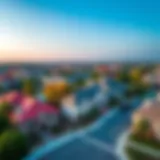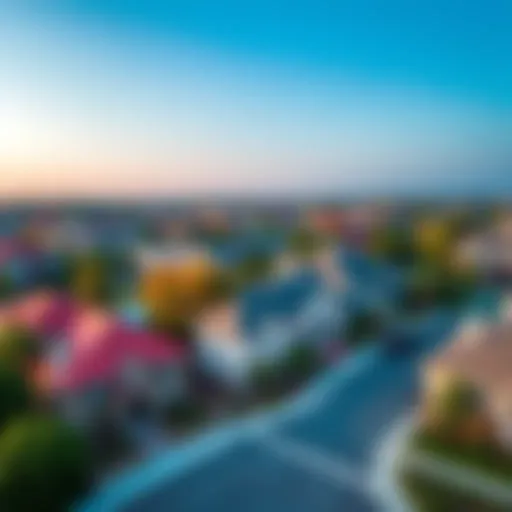Exploring the Cultural Significance of Bayt Al Safa
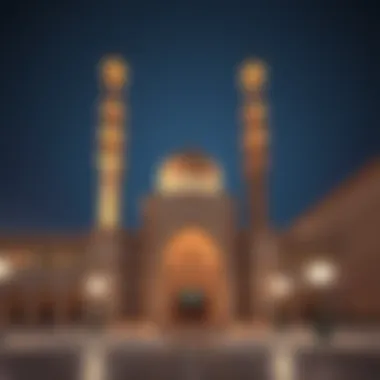

Intro
Bayt Al Safa stands as a testament to Dubai's rich tapestry of culture and history. Nestled in a vibrant neighborhood, this heritage site offers a glimpse into the life of the UAE during a time shaped by tradition and resilience. Understanding its significance not only illuminates Dubai's past but also highlights the role it plays in the city’s present and future.
The architectural features of Bayt Al Safa encapsulate the aesthetic values of the region, characterized by intricate design and thoughtful use of space. The relevance of this site stretches far beyond mere bricks and mortar; it weaves a narrative of community, identity, and heritage.
With the backdrop of rapid modernization, the exploration of Bayt Al Safa becomes particularly pertinent. Not only does it reflect local history, but it also serves as a focal point for investors and residents drawn to the evolving cultural landscape of Dubai. Highlighting key historical events, architectural marvels, and community engagement practices, this article will navigate through the various dimensions that make Bayt Al Safa a pivotal reference point in contemporary discussions around culture, real estate, and socially responsible living.
As Dubai accelerates into the future, the preservation and appreciation of its heritage sites like Bayt Al Safa underscore the significance of balancing growth with respect for history. Therefore, it is crucial to delve into this cultural exploration, revealing the layers of influence and the ongoing dialogue between past and present.
Prolusion to Bayt Al Safa
Bayt Al Safa stands as a remarkable beacon of cultural and historical value in Dubai, a city known for its rapid development and modernity. This site is not just a structure of bricks and mortar; it embodies the spirit and evolution of Emirati heritage. Understanding Bayt Al Safa means diving into a world where tradition meets progress and where the past seamlessly intertwines with the present.
As we explore this article, we'll see how Bayt Al Safa plays a pivotal role in Dubai's identity. It's not merely a tourist attraction but a gateway into the cultural psyche of the Emirati people. Understanding its historical context reveals how it has shaped local customs, social interactions, and architectural ideals over the years.
Historical Overview
Bayt Al Safa traces its origins back to an era when Dubai was emerging as a center of trade and culture in the Gulf region. Constructed in the mid-20th century, the building served as the residence of Sheikh Rashid bin Saeed Al Maktoum, a key figure in Dubai's transformation.
The architecture is a vivid representation of a time that preceded skyscrapers and complex infrastructure. Its simple layout and robust materials tell stories of resilience and adaptability. The residence stood as a hub not only for the ruling family but also for citizens seeking counsel, underscoring its role in the governance and social fabric of the time.
Moreover, the site has witnessed significant events that have shaped Dubai's political landscape. The conversations that took place within its walls reflect the aspirations and struggles faced by the community. Bayt Al Safa isn’t just a structure; it's a witness to history, echoing tales of growth and ambition through its very foundation.
Cultural Significance
Bayt Al Safa is much more than a former royal residence; it is a living testament to the rich cultural heritage of the Emirati people. The building exemplifies the harmonious blend of tradition and modernity that characterizes Dubai today. As a cultural site, it serves as a venue for various events that celebrate Emirati arts, music, and literature.
Here are a few essential elements regarding Bayt Al Safa's cultural significance:
- Community Engagement: The site is often used for exhibitions and cultural festivals that allow locals and expatriates to engage with Emirati traditions. This creates a platform for dialogue and understanding among diverse communities.
- Educational Programs: Bayt Al Safa hosts workshops and talks aimed at educating the younger generation about their heritage. This initiative strengthens the cultural legacy by ensuring that the youth remain connected to their roots.
- Symbol of Identity: For many Emiratis, Bayt Al Safa symbolizes national pride. Its preservation reflects a commitment to honoring the past while looking forward to a prosperous future.
In essence, the cultural significance of Bayt Al Safa goes beyond its architectural beauty; it represents a collective memory for the people of Dubai, offering insights into their values, beliefs, and aspirations.
"Bayt Al Safa is not only a structure; it embodies the dreams and aspirations of its people," a local historian notes.
Understanding Bayt Al Safa enriches one's appreciation of Dubai's journey—from a small fishing village to a global hub of commerce. This exploration of its historical and cultural significance is a crucial step in recognizing the heart of what makes Dubai unique.
Architectural Features
Architectural features form the backbone of Bayt Al Safa, defining not only its external aesthetic but also its cultural significance. This section sheds light on the distinctive design elements and construction techniques that have shaped this monumental structure in Dubai. Understanding these features offers insights into the architectural heritage of the region and its relevance in today's urban landscape.
Design Elements
When you first set eyes on Bayt Al Safa, one can't help but notice its harmonious blend of traditional and modern aesthetics. The use of arish, a type of palm frond, in its construction illustrates a resourcefulness and connection to the local environment that goes beyond mere visual appeal. This material offers critical insulation against the harsh desert climate. Another distinct feature is the expansive courtyard, which not only enhances ventilation but also fosters a sense of community, embodying the cultural ethos of togetherness.
The rhythmic arrangement of arches, columns, and intricate woodwork catches the eye and invites exploration. It's worth mentioning that the structure employs mashrabiya, an exquisite form of wooden latticework, designed to provide shade and privacy without compromising airflow. This is a classic element in Islamic architecture that reflects an understanding of environmental factors while promoting social interactions.
Key aspects of the design include:
- Spatial Dynamics: Each room flows organically into another, creating an open feel yet distinct spaces for family gatherings and private moments.
- Color Palette: The use of earthy tones harmonizes the building with its surroundings, embracing the natural desert that frames it.
- Landscaping: Thoughtfully placed vegetation around the building not only enhances beauty but also provides shade and improves the micro-climate.
Construction Techniques
The construction techniques employed in Bayt Al Safa are as fascinating as the building’s visual elements. Using traditional building methods, artisans relied heavily on locally sourced materials. This approach not only underscores sustainable practices but also enhances the building's connection to its setting.
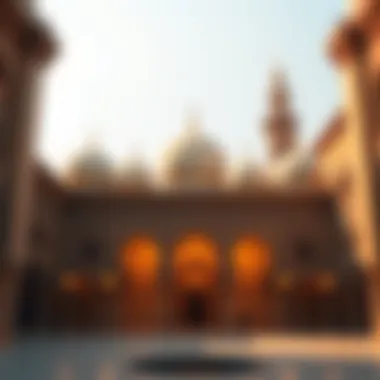

Mortar mixed from sand and limestone resulted in sturdy walls that withstand the external elements. The skillful craftsmanship of artisans plays a crucial role here; each brick and timber piece was meticulously crafted to ensure durability and aesthetic value in one package. Moreover, the method of hand-chiseling stone into intricate designs has been passed down through generations, preserving the local craftsmanship and connecting present generations to their rich history.
The innovative use of vaulted ceilings serves dual purposes: they elevate the aesthetic appeal and aid in cooling by allowing hot air to rise.
This unique marrying of old and new makes Bayt Al Safa a distinctive marker in the landscape of Dubai's heritage architecture. As investors or real property buyers contemplate their next move, understanding these architectural nuances could provide a potent insight into the value these features bring to the property market today.
In summary, the architectural features of Bayt Al Safa are not just elements of design, but rather a narration of the past that resonates with the present. Investing in properties like these means investing in a legacy that reaches back to the roots of Dubai's cultural identity.
"Bayt Al Safa stands as a testament to architectural ingenuity, intertwining the legacy of tradition with the aspirations of modernity."
For more insights into heritage architecture, you may explore Britannica or Wikipedia.
The Role of Bayt Al Safa in Dubai’s Heritage
The significance of Bayt Al Safa stretches far beyond its physical structure. This site is emblematic of Dubai's cultural narrative and historical heritage. For residents, investors, and developers, Bayt Al Safa symbolizes a connection to the past amid a rapidly modernizing landscape. Understanding its role in Dubai’s heritage unveils layers of meaning attached to the community, traditions, and values that continue to shape social interactions today.
Civic Engagement
Civic engagement at Bayt Al Safa is a tapestry woven from threads of history, culture, and community. The location is more than just a gathering point; it's a forum for cultural dialogue and social activism. By hosting various events, community meetings, and cultural exhibitions, Bayt Al Safa fosters a sense of belonging among residents. This engagement allows individuals to voice their concerns and aspirations, contributing to a dynamic civic environment.
Visitors to Bayt Al Safa may participate in workshops that encourage local artistry, traditional crafts, and even sustainable practices. Such initiatives are key in galvanizing the local population to contribute actively to community development. The interaction between residents and heritage becomes a two-way street, where memory and innovation merge to enrich the cultural landscape. Consequently, this dynamic boosts local pride and enhances community ties.
Moreover, the role of civic engagement at Bayt Al Safa isn't contained within the walls of the heritage site. The conversations and connections made here often ripple into bigger societal changes, influencing policy and public discourse. The center stands as a landmark of civic responsibility, pushing the envelope for public participation in preserving and enhancing Dubai's cultural fabric.
Educational Programs
Education opens doors, and at Bayt Al Safa, it opens gates to a deeper understanding of local heritage. The educational programs offered here serve a dual purpose: they preserve the history of Dubai while equipping younger generations with the tools they need to keep it alive. Through interactive learning experiences, students and visiting scholars alike can acquire insights into the traditions, values, and customs that define the emirate's identity.
Classes and workshops might include subjects ranging from traditional Arabic calligraphy to local cooking classes that emphasize regional ingredients. Such programming is designed not just as a means of education but also as a method of cultural preservation. Participants are encouraged to engage with their heritage in meaningful ways, thus ensuring it doesn’t quietly fade into the background.
Sustainability is another focus of these programs. Bayt Al Safa positions itself as a platform for educating the community about environmental stewardship, thereby integrating modern societal needs with traditional practices. In this way, it becomes a living example of how historical knowledge can inform contemporary lifestyles.
"The future of our culture relies heavily on how well we educate today’s youth about their roots. Bayt Al Safa stands as a bastion of that educational mission."
Through these efforts, Bayt Al Safa ensures that the essence of Dubai’s heritage is not merely preserved, but actively lived out by new generations. All in all, it functions as a critical touchpoint where the past and future meet, drawing in both locals and expatriates alike.
These elements are crucial as they demonstrate how Bayt Al Safa not only anchors Dubai's past but also nurtures a vibrant present and future.
Bayt Al Safa and Real Estate in Dubai
The relationship between Bayt Al Safa and the real estate landscape of Dubai is more intricate than a tangled ball of yarn. This heritage site stands as a testament not only to the city’s rich history but also influences the dynamics of property values and investment opportunities in the vicinity. In light of Dubai’s rapid urbanization and the ever-evolving real estate market, Bayt Al Safa serves as a cornerstone for cultural identity while playing a pivotal role in the property sector.
Impact on Surrounding Property Values
Examining the impact of Bayt Al Safa on property values yields a fascinating perspective. The presence of historical sites like Bayt Al Safa tends to create an air of authenticity and prestige around the neighborhood. Investors and homebuyers often seek such locations that could offer more than just a roof over their heads. Here, we see how proximity to cultural landmarks can command premium pricing in the real estate market.
- Cultural Appeal: Homes near Bayt Al Safa often carry a historical narrative, attracting buyers who appreciate the blend of modern living entwined with cultural heritage.
- Investor Interest: Developers frequently eye properties surrounding heritage sites for potential high ROI, resulting in premium property pricing.
- Community Dynamics: As the cultural status of Bayt Al Safa rises, so does the allure of the surrounding area for affluent individuals and families, driving demand higher.
Given these points, it's evident that Bayt Al Safa's role extends far beyond tourism; it actively shapes the local real estate market.
Tourism and Investment Opportunities
In the sphere of tourism and investment, Bayt Al Safa emerges as a beacon. The site not only attracts visitors but also opens doors for unique business opportunities. Understanding the intricacies of this geography can yield substantial benefits for investors and entrepreneurs alike.
- Visitor Influx: Bayt Al Safa draws a diverse audience, from cultural enthusiasts to local students, which naturally stimulates the economy. Businesses around this area reap the rewards of foot traffic, creating an ecosystem that supports both tourism and commerce.
- Cultural Events and Programs: Events hosted at Bayt Al Safa foster community engagement, often attracting sponsors and investors interested in tapping into local markets. These events range from art exhibitions to educational forums, each offering sponsorship opportunities.
- Real Estate Developments: Given the site’s cultural significance, property developers often capitalize on the appeal of the area, creating mixed-use developments that blend residential, commercial, and cultural spaces.
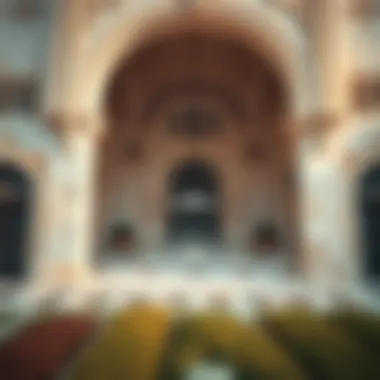

Ultimately, the investment landscape surrounding Bayt Al Safa is rife with potential. It draws a diverse mixture of stakeholders, from government entities looking to preserve heritage to private investors eager to capitalize on commercial opportunities. As the site continues to thrive, the surrounding real estate market is poised for considerable growth.
Preservation of Bayt Al Safa
The preservation of Bayt Al Safa stands as a linchpin in the maintenance of Dubai's rich cultural fabric. This heritage site doesn't merely represent a building; it is a testament to the lifestyle, traditions, and community values of the past. Without focused preservation efforts, we risk losing not just a structure but the stories it embodies and the lessons it imparts to future generations. There’s no denying that keeping such landmarks alive ensures they serve as both heritage and inspiration in a rapidly evolving urban landscape.
Conservation Efforts
Conservation efforts at Bayt Al Safa have been multifaceted, weaving together practical, emotional, and cultural threads. The restoration of the site involves a meticulous approach to maintaining its historical integrity while integrating modern technologies. Specialists engage in thorough research to select the appropriate materials that adhere to traditional construction styles, ensuring any renovations or repairs do not compromise the authenticity of its original design.
For instance, the traditional plastering techniques used in structures reveal much about the architectural practices of earlier eras. It isn’t just about fixing cracks but reinstating the lost charm of this remarkable building. Additionally, environmental considerations are being made to ensure that the preservation processes are sustainable. This involves careful planning to mitigate impact on surrounding ecosystems while ensuring the site remains a viable destination for educated tourism and community interaction.
Community Involvement
Community involvement serves as a backbone for the preservation of Bayt Al Safa. Local residents and organizations often participate in heritage workshops and events aimed at understanding the significance of their cultural landmarks. These workshops foster a sense of ownership and responsibility, laying the groundwork for grassroots support in conservation. The symbiotic relationship between the community and Bayt Al Safa cultivates pride.
Moreover, initiatives such as farmer's markets and traditional art exhibitions help to solidify the site as a living space where culture is not just preserved but actively celebrated. Local artists showcasing their works alongside live performances can be found here, transforming Bayt Al Safa into a vibrant cultural hub. This interactive approach helps the public perceive the site as part of their life, instead of merely a relic of the past.
Bayt Al Safa’s Influence on Contemporary Architecture
Bayt Al Safa stands as a testament not only to its rich history but also to its significant influence on contemporary architecture in Dubai and beyond. This site has ushered in a wave of inspiration that draws from its traditional elements while integrating modern innovations. As such, the architectural trends and integrations stemming from Bayt Al Safa are worth exploring thoroughly.
Architectural Trends
In recent years, architects and designers have taken cues from the aesthetic and functional features of Bayt Al Safa. Here are some notable trends that highlight this influence:
- Use of Natural Materials: Just like the traditional structures in the Bayt Al Safa, many modern designs favor materials such as stone and wood, which offer not only ecological benefits but also aesthetic warmth.
- Courtyard Design: The internal courtyards prominent in Bayt Al Safa have inspired a resurgence in their use. Courtyards create a sense of tranquility, allowing natural light and air to enter, improving livability in urban settings.
- Cultural Fusion: Designers are increasingly blending modern minimalist styles with traditional Arabic architectural elements, creating spaces that celebrate the past while looking to the future. This fusion can be seen in the intricate tile work, decorative arches, and mashrabiya screens.
Public Perception of Bayt Al Safa
Understanding the public's perception of Bayt Al Safa is crucial, as it reveals the multilayered significance this heritage site holds for the community, investors, and policymakers. It's not just about bricks and mortar; it embodies the stories, customs, and beliefs of the people connected to this historical landmark. Perceptions can shape narratives surrounding conservation, tourism, and even real estate development, making this analysis vital.
Visitor Experiences
Experiences of visitors at Bayt Al Safa often weave a rich tapestry showcasing its cultural and historical relevance. Many say that walking through the site feels like stepping back in time, bridging the past and the present. This unique sentiment underscores a sense of connection, as visitors engage with the architecture and surroundings that tell their own stories.
A common thread among guest remarks showcases how the site fosters a deeper understanding of Emirati culture. For instance, local tours sometimes include nuggets of wisdom shared by seasoned guides. They often voice tales of the place's foundation and evolution, drawing parallels to modern-day Dubai. Rich conversations arise, highlighting how the heritage site informs contemporary identity. Some visitors come for educational reasons, whilst others may seek inspiration for their own endeavors in art or architecture, that aligns more with traditional designs instead of contemporary skyscrapers that dominate Dubai’s skyline.
“Bayt Al Safa isn’t just a visit; it’s an experience that affirms our cultural roots,” shared a recent visitor, encapsulating the general sentiment around this crucial landmark.
Media Representation
The way Bayt Al Safa is depicted in various media outlets greatly contributes to its public perception. Articles, documentaries, and social media coverage all work to shape how the site is viewed both locally and internationally. Often, media representations focus on the intricate architectural features and the vivid stories behind them. They also highlight the importance of preserving cultural heritage amid rapid urbanization, portraying it as a beacon of identity in a city characterized by its relentless growth.
In some reports, Bayt Al Safa is featured as a case study in balancing progress with preservation—an aspect that resonates deeply with both residents and expatriates. The conversation in media circles frequently touches upon the balance of modern development with cultural respect, which strikes a chord with many who see the site as a symbol of Dubai’s unique character.
This rich media narrative establishes Bayt Al Safa not merely as a tourist attraction but as a crucial part of Dubai's ongoing story—one that is worth preserving for future generations. By leveraging platforms like local blogs and popular social media channels, advocates for the site have a conducive space to rally support for preservation and community involvement. It shows that Bayt Al Safa is popular not only among tourists but also among expatriates and residents who see it as a living museum, merging their own experiences with the site's historical context.
In summary, public perception of Bayt Al Safa serves as a dynamic lens through which one can appreciate its prevailing value. Both visitor experiences and media representation help to ensure that this cultural site is recognized as a cornerstone of Dubai’s identity, deserving of attention and care in the years to come.
Comparative Analysis
In the exploration of Bayt Al Safa, comparative analysis plays a pivotal role by shedding light on the confluence of historical and cultural narratives that are common across various heritage sites. Understanding Bayt Al Safa in relation to similar sites not only enhances its significance but also contributes to a broader understanding of the cultural heritage landscape. This analysis offers insights into the architectural styles, socio-economic impacts, and preservation strategies that are prevalent in heritage conservation.
The importance of comparative analysis lies in its ability to draw connections and highlight differences across heritage sites. Examining the similarities and contrasts between Bayt Al Safa and other sites can provide investors and stakeholders with a clearer perspective on the value of heritage preservation. For example, stakeholders might evaluate how preservation efforts in Bayt Al Safa measure up against those at sites like Al Fahidi Historical Neighborhood or the Sheikh Mohammed Centre for Cultural Understanding.
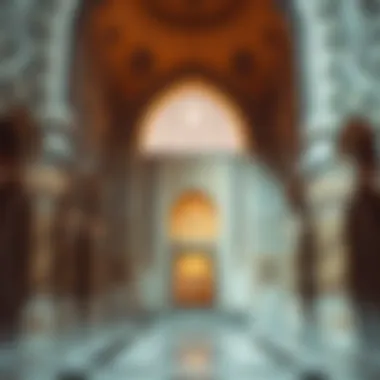

Key elements of comparative analysis include:
- Cultural Context: Understanding how heritage sites reflect the values and traditions of their respective societies.
- Architectural Styles: Analyzing design choices that resonate with certain historical periods or cultural shifts.
- Community Engagement: Examining how sites foster civic identity and participation among local populations.
Comparative analysis serves as a framework for assessing the benefits of preserving Bayt Al Safa. It helps articulate the broader implications for Dubai's cultural landscape, as it connects with global initiatives for heritage conservation.
“Engaging with the past enriches our understanding of the present and shapes the future.”
Similar Heritage Sites
When discussing Bayt Al Safa, it's essential to draw parallels with other heritage sites that have faced similar challenges and triumphs in the face of modern development. Notable examples include:
- Al Fahidi Historical Neighborhood: A bustling hub that showcases Dubai's Emirati culture and art. Its preservation strategy emphasizes adaptive reuse of structures to accommodate modern needs while honoring history.
- Dubai Museum: Situated in Al Fahidi Fort, this site offers insights into the emirate's rapid transformation from a fishing village to a cosmopolitan city. The museum's success highlights the importance of community involvement in heritage conservation.
- Sheikh Mohammed Centre for Cultural Understanding: This center not only preserves the traditional way of life but also promotes intercultural dialogue. Its program offerings are a testament to the role of education in heritage preservation.
These sites demonstrate how Dubai is actively engaging with its cultural past, allowing stakeholders to glean insights into effective preservation strategies and community involvement.
Global Perspectives on Heritage Preservation
The preservation of Bayt Al Safa must be viewed through a global lens, as many communities across the globe are grappling with the implications of modernity on their historical artifacts. Understanding global practices and philosophies surrounding heritage preservation can inform local efforts in Dubai.
Internationally, several conventions and charters guide preservation practices. The UNESCO World Heritage Convention, for instance, lays out criteria for which sites are deemed significant enough to merit protection on a global scale. By engaging with these frameworks, stakeholders in Dubai can align their efforts with successful international methodologies.
Considerations in Global Perspectives:
- The impact of urbanization on heritage sites. Many cities, much like Dubai, manage a delicate balance between development and preservation.
- Technological Innovations: Methods such as digital archiving and virtual reconstructions have revolutionized the way heritage is preserved and showcased.
- Community-Led Initiatives: Local involvement has emerged as a crucial factor in successful preservation worldwide, demonstrating the value of grassroots movements in protecting heritage.
By synthesizing these global perspectives, the relevance of Bayt Al Safa becomes clearer, as it stands within a network of cultural significance that transcends borders and speaks to the shared human experience.
Future of Bayt Al Safa
The future of Bayt Al Safa stands as a crucial focal point for discussions surrounding heritage preservation and cultural sustainability. As the winds of change blow through Dubai, the significance of maintaining the essence of historical sites like Bayt Al Safa cannot be overstated. It serves as a bridge between the past and the present, reflecting societal values, aesthetics, and the aspirations of the local community. The future developments surrounding this heritage site will shape not just its physical presence but also its continued relevance to both residents and investors alike.
Potential Developments
As the city continues to evolve at a rapid pace, the potential developments around Bayt Al Safa should be approached with thoughtfulness and a strong sense of identity. Several aspects merit attention:
- Integration of Technology: Incorporating modern technologies such as virtual reality or digital displays can enhance visitor experiences without detracting from the site's authenticity. Imagine walking through its halls and having an interactive guide tailor experiences based on individual interests.
- Community Spaces: Future plans could include spaces designated for community engagement—art exhibitions, workshops, or public lectures—thereby fostering a sense of belonging and responsibility towards cultural heritage.
- Green Initiatives: Establishing eco-friendly practices within the site's management and surrounding areas can promote sustainability, drawing in environmentally-conscious visitors. This might include solar panels, waste recycling programs, and native landscaping to preserve local biodiversity.
- Cultural Festivals: Hosting annual cultural festivals dedicated to the arts, culinary heritage, and traditional crafts can attract a diverse audience, allowing visitors to dive deeper into local customs and practices.
These developments not only enhance the visitor's journey but also solidify Bayt Al Safa's place as a central cultural hub in Dubai, making it equally attractive for investors who recognize the value in preserving cultural legacies.
Long-term Strategic Goals
For Bayt Al Safa, the long-term strategic goals must reflect not only the desire for preservation but also for growth and relevance in a world that changes with each passing day. A careful balance is vital:
- Sustained Financial Support: Aligning with both government and private sectors for funding can secure financial stability, enabling ongoing maintenance and innovative projects.
- International Collaborations: Engaging with global cultural institutions might open doors for partnerships which could lead to resource sharing, expert collaboration, and international exposure.
- Fostering Local Pride: It's essential to cultivate a local narrative around Bayt Al Safa that resonates with residents. Educational programs and involving local schools will ensure that the next generation appreciates and upholds this cultural landmark.
- Adaptive Re-use: Considering flexible spaces that can be utilized for various events or exhibits can help keep the site dynamic and in sync with contemporary culture while respecting its historical roots.
Ensuring that these goals are met will position Bayt Al Safa not just as a relic of the past, but as an active participant in shaping the future of Dubai's cultural landscape.
Epilogue
In concluding the exploration of Bayt Al Safa, it is essential to recognize the cultural and historical relevance of this unique heritage site. Shaped by its architectural beauty and deep-rooted history, Bayt Al Safa stands as a testament to Dubai’s commitment to preserving its rich past while fostering a vibrant future. This site encapsulates the essence of local traditions and serves as a vital reference point for investors, residents, and the community at large.
Summation of Key Points
- Historical Significance: Bayt Al Safa is not merely a building but a narrative woven into the fabric of Dubai's history, reflecting the social changes and regional dynamics over the years.
- Architectural Features: The design elements and construction techniques used in Bayt Al Safa highlight sustainability and adaptation, characteristics that echo in contemporary architecture across Dubai.
- Civic Engagement: The role of Bayt Al Safa in community education and public discourse emphasizes the importance of continued engagement with heritage.
- Impact on Real Estate: With the rising interest in cultural sites, Bayt Al Safa influences property values and shapes investment opportunities for those looking to embed themselves in a rich cultural landscape.
- Future Prospects: The ongoing preservation efforts reflect a broader commitment to maintaining heritage amid rapid modern development.
Call to Action for Preservation Efforts
To ensure the longevity of Bayt Al Safa, active participation in preservation efforts is crucial. Community involvement can take many forms, from volunteer efforts to advocacy for funding and awareness campaigns. Here are some actions that can help:
- Participate in Local Initiatives: Join local organizations focused on heritage preservation. This community engagement can bring attention to Bayt Al Safa and enhance its visibility.
- Support Educational Programs: Contribute to or involve yourself in educational programs aimed at informing the younger generations about the cultural significance of such sites.
- Advocate for Sustainable Practices: Emphasize the need for responsible development practices that align modern growth with heritage conservation, ensuring that the essence of Bayt Al Safa remains intact.
“Preserving our heritage is not just about maintaining structures; it's about keeping our stories alive.”
